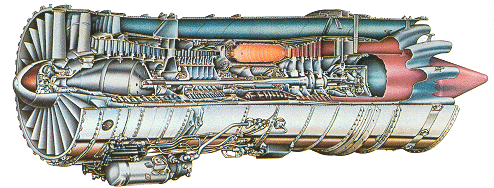History
The original choice of powerplant was the Pratt & Whitney JT8D-1, but before the first order had been finalised the JT8D-7 was used for commonality with the current 727. The -7 was flat rated to develop the same thrust (14,000lb.st) at higher ambient temperatures than the -1 and became the standard powerplant for the -100. By the end of the -200 production the JT8D-17R was up to 17,400lb.st. thrust.
Auxiliary inlet doors were fitted to early JT8D's around the nose cowl. These were spring loaded and opened automatically whenever the pressure differential between inlet and external static pressures was high, ie slow speed, high thrust conditions (takeoff) to give additional engine air and closed again as airspeed increased causing inlet static pressure to rise.
The sole powerplant for all 737's after the -200 is the CFM-56. The core is produced by General Electric and is virtually identical to the F101 as used in the Rockwell B-1. SNECMA produce the fan, IP compressor, LP turbine, thrust reversers and all external accessories. The name "CFM" comes from GE's commercial engine designation "CF" and SNECMA's "M" for Moteurs.

One problem with such a high bypass engine was its physical size and ground clearance; this was overcome by mounting the accessories on the lower sides to flatten the nacelle bottom and intake lip to give the "hamster pouch" look. The engines were moved forward and raised, level with the upper surface of the wing and tilted 5 degrees up which not only helped the ground clearance but also directed the exhaust downwards which reduced the effects of pylon overheating and gave some vectored thrust to assist take-off performance. The CFM56-3 proved to be almost 20% more efficient than the JT8D.
The NG's use the CFM56-7B which has a 61 inch diameter solid titanium wide-chord fan, new LP turbine turbomachinery, FADEC, and new single crystal material in the HP turbine. All of which give an 8% fuel reduction, 15% maintenance cost reduction and greater EGT margin compared to the CFM56-3.
One of the most significant improvements in the powerplant has been to the noise levels. The original JT8D-9 engines in 1967 produced 75 decibel levels, enough to disrupt normal conversation indoors, within a noise contour that extended 12 miles along the take-off flight path. Since 1997 with the introduction of the 737-700’s CFM56-7B engines, the 75-decibel noise contour is now only 3.5 miles long.
The core engine (N2) is governed by metering fuel (see below), whereas the fan (N1) is a free turbine. The advantages of this include: minimised inter-stage bleeding, fewer stalls or surges and an increased compression ratio without decreasing efficiency.
This quote from CFMI in 1997:
"Since entering service in 1984, the CFM56-3 has established itself as the standard against which all other engines are judged in terms of reliability, durability, and cost of ownership. The fleet of nearly 1,800 CFM56-3-powered 737s in service worldwide have logged more than 61 million hours and 44 million cycles while maintaining a 99.98 percent dispatch reliability rate (one flight delayed or cancelled for engine-caused reasons per 5,000 departures), a .070 shop visit rate (one unscheduled shop visit per 14,286 flight hours), and an in-flight shutdown rate of .003 (one incident per 333,333 hours)."


No comments:
Post a Comment